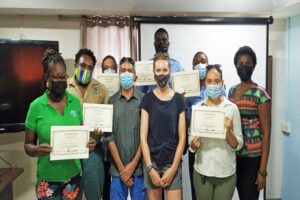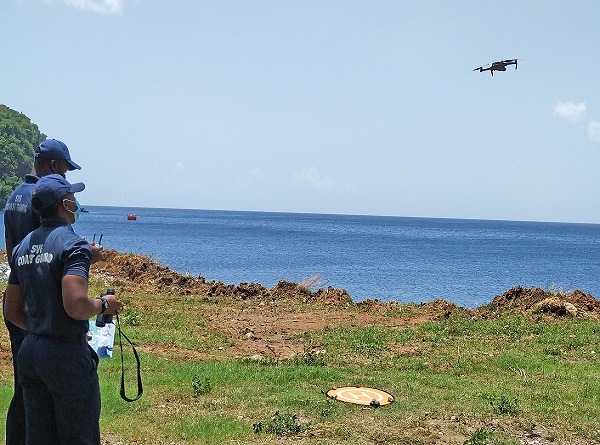Monitoring wildlife can be challenging in remote or difficult to reach places. The use of an Unmanned Aerial Vehicle (UAV), also known as a drone, is one method for ensuring that local enforcement agencies can monitor and protect wildlife, such as seabirds which nest on uninhabited islands in the Grenadines.
A workshop held last week in St. Vincent worked towards this goal of building capacity for drone-flying skills and data collection. Six participants spent five days in the classroom and in the field learning about UAV safety, maintenance, privacy issues, data analysis, and avoiding wildlife disturbance. All trainees learned to successfully fly and land the drones following pre-determined grids and waypoints.

SVG Drone Training group – Representatives of several government agencies successfully completed the drone training course. (Photo: Lystra Culzac/EPIC)
The training was led by Serge Wich and assistant Katie Doull of ConservationDrones, based out of the United Kingdom. Mr. Wich noted, “the participants were all eager to learn about drone flying and picked up the theory and practical work very quickly.”
Lystra Culzac managed the project on behalf of Environmental Protection in the Caribbean (EPIC), based in the United States, while also providing knowledge and context based on her years of environmental research in St. Vincent and the Grenadines. Ms. Culzac gained new skills and knowledge in the training as well and reported that “managed properly, UAV can become a valuable tool in local efforts to conserve island biodiversity.”
St. Vincent and the Grenadines is home to numerous species found nowhere else in the world and also harbors globally and regionally important nesting areas for seabirds. Drones can not only collect data on these precious natural resources but also identify threats to biodiversity such as fires, illegal harvest, and non-native mammals, all of which threaten species protected under the Wildlife Protection Act.
EPIC would like to thank agencies that participated in the training, including the St. Vincent and the Grenadines Coast Guard Services, Fisheries Division, Forestry Department, and Tobago Cays Marine Park. Participant Delight Ollivierre expressed her appreciation for the opportunity and noted, “…these skills and concepts learnt will enable the Fisheries Division to collect meaningful visual data from a new perspective – a bird’s eye view – which will allow our respective agencies to broaden our understanding of the dynamic environments and biological communities in St. Vincent and the Grenadines.”
Information collected by trainees can be shared among agencies and with EPIC, which maintains a database of wildlife observations and threats for the Grenadines. A WhatsApp group for participants encourages dialogue, support, and data sharing as they develop their own programs. This crucial information can also be integrated into management plans, such as for marine protected areas or the Grenadines Seabird Conservation Management Plan.
This project is made possible with support from the Bio-Bridge Program of the Secretariat of the Convention on Biological Diversity, the U.S. Fish and Wildlife Service, and U.S. Agency for International Development.



